Ask the Lighting Expert
- Why is exhibit lighting important?
- Why do some exhibit managers forgo or overlook properly lighting their exhibits?
- How does lighting change the experience of an exhibit?
- What to consider when buying online.
- What's the Difference between Lumens & Watts?
- What is a PCB?
- What is LED optics?
- What is DMX 512?
- What is RGB?
- What is the difference between Task Lighting and Accent Lighting?
- What are Lumens?
- Why is there such a price difference between different LED suppliers for LED flexible ribbon lighting?
- Does LED lighting get hot?
- What Dimmers are recommeded for use with TRAIC Power Supplies?
Q: Why is exhibit lighting important?
A: Exhibit Lighting has always been an important component with trade show exhibits for the critical task of illuminating the exhibit space, graphics and products. If you walk down a trade show isle and an exhibitor decides to forgo lighting, the space is quite dark and essentially sends a message that “we’re closed for business”.
Good Lighting adds spark to an exhibit space and in the past few years has transformed from being a “necessary” item to an integral design component, especially with the advent of LED Lighting Technology. The emergence of the Light Emitting Diode has revolutionized lighting and the trade show industry has benefited greatly, especially from a creative perspective.
LED allows the exhibit space to be illuminated in a full spectrum of colors, allowing the exhibitor to choose from warm comfort colors to bright highlight colors. This is a far cry from the days exhibitors were relegated to hot yellow halogen lights.
LED has taken exhibit lighting to new heights as it allows the Exhibit Designer to “paint” with lighting which has impacted the way the creative process flows. Instead of lighting being the last minute afterthought, it has become a design element in the forefront of a project.
Q: Why do some exhibit managers forgo or overlook properly lighting their exhibits?
A: Lighting has historically been a “necessary evil” for tradeshow managers because the expense of managing fragile hardware (glass, gases, hot filaments, etc.) and it was riddled with challenges such packing, I&D, assembly, easily damaged and electrical challenges. In the past, lighting required a significant amount of electricity which needs to be rented at every show. This all adds up, increasing the cost of exhibit ownership, so when exhibit managers look for ways to be within budget, lighting is one of the components that can be overlooked.
LED has simplified lighting challenges as it is extremely durable, compact, and easy to assemble and many times packs permanently with exhibit components (no assembly required). One of the greatest benefits of LED is energy savings as it uses up to 90% Less Electricity than traditional lighting. Exhibit Managers can be hero’s to their customers by incorporating state of the art LED Lighting, adding a new dimension to their exhibit and saving valuable budget dollars at the same time!
Q: How does lighting change the experience of an exhibit?
A: LED light has truly changed the trade show booth experience in many creative ways. From proper lighting look (color temperature) to enhancing graphics / product, and finishing with special effects such as animating with light. No longer does the exhibitor have to rely on existing venue lighting at the convention hall, or static yellow hot halogen lighting, costing hundreds of dollars to rent electricity. When doing multiple shows annually, savings on power and labor allows budget dollars to be allocated in others areas, or simply reducing costs.
LED offers greater control with achieving the preferred light. If the exhibitor wants interactive color changing or color temperature control, LED lighting allows for this. Most recently rechargeable battery technology combined with low wattage LED lighting, an exhibitor in no longer bound by the extension cord and high cost of running underfloor power. Flexibility with incorporating creative stand-alone lighting effects allows the creative process to step outside the box.
Q: What to consider when buying online.
A: The exhibitor needs to understand LED lighting hardware and its longevity (ROI) warrants sourcing high quality products, along with a company that stands behind the products it produces or represents. The internet is a double-edge sword as it offers tremendous ability to search for LED Lighting Products and compare prices instantly, but at the same time, quality cannot be guaranteed until it is in the hands of the exhibit builder. And equally important is working with a Lighting supplier that stands behinds its products when things don’t go exactly as planned.
We recommend using a supplier with lighting experience in the industry, LED lighting knowledge and able to work directly with the exhibit builder. The ideal lighting supplier should be considered a LED Lighting support center for the exhibit builder, working with sales staff, designers, engineers, projects managers and fabricators, to assist with every project involving lighting requirements.
Q: What's the Difference between Lumens & Watts?
A: 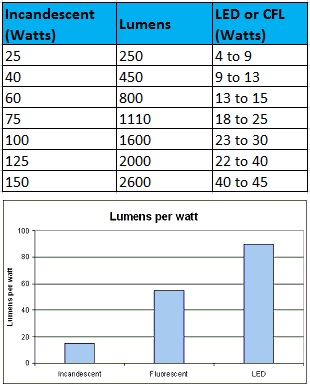 Wattage (measured in watts) is the power required to operate a light. It refers to the total electricity that is consumed which includes: the heat generated by the light source; the operational aspects depending on the type of lighting device; and, the energy of the light emitted from the bulb or tube. So, the rated wattage of a light source refers to the entire power consumed to drive the source.
Wattage (measured in watts) is the power required to operate a light. It refers to the total electricity that is consumed which includes: the heat generated by the light source; the operational aspects depending on the type of lighting device; and, the energy of the light emitted from the bulb or tube. So, the rated wattage of a light source refers to the entire power consumed to drive the source.
Lumens refer to the light output of a light or lamp. It’s the measurement of the rate at which a lamp is able to convert electrical power (watts) to light (lumens). This is referred to as “luminous efficacy” and is expressed in lumens per watt (LPW) or sometimes lumens per circuit watt.
Examples of luminous efficacy in common light sources include:
Incandescent/halogen bulb – 17 lumens/watt
A 32W T5 or T8 fluorescent tube - 50 lumens/watt
High pressure sodium bulb – 80 lumens/watt
Metal halide lamp - 95 lumens/watt
LED lighting- 80-120+ lumens/watt
Q: What is a PCB?
A: 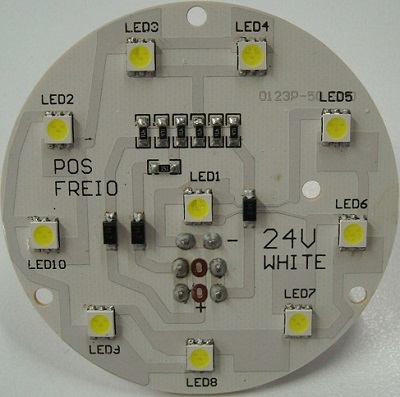 A printed circuit board, or PCB, is used to mechanically support and electrically connect electronic components using conductive pathways, tracks or signal traces etched from copper sheets laminated onto a non-conductive substrate.
A printed circuit board, or PCB, is used to mechanically support and electrically connect electronic components using conductive pathways, tracks or signal traces etched from copper sheets laminated onto a non-conductive substrate.
When the board has only copper tracks and features, and no circuit elements such as capacitors, resistors or active devices that have been manufactured into the actual substrate of the board, it is more correctly referred to as printed wiring board (PWB) or etched wiring board.
Use of the term PWB or printed wiring board although more accurate and distinct from what would be known as a true printed circuit board, has generally fallen by the wayside for many people and the distinction between circuit and wiring has become blurred.
Today printed wiring (circuit) boards are used in virtually all but the simplest commercially produced electronic devices, and allow fully automated assembly processes.
Q: What is LED optics?
A: 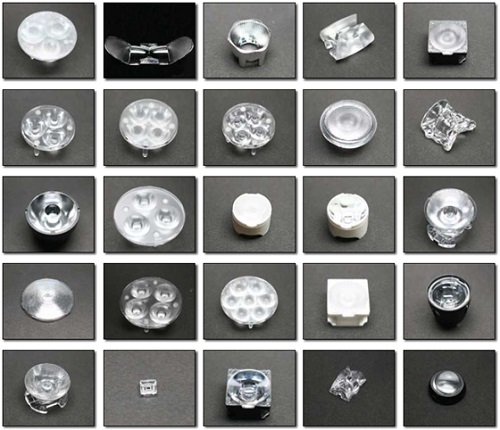 A lens is an optical device which transmits and refracts light, converging or diverging the beam to specified angles as the optic lens is designed.
A lens is an optical device which transmits and refracts light, converging or diverging the beam to specified angles as the optic lens is designed.
A simple lens consists of a single optical element. A compound lens is an array of simple lenses (elements) with a common axis; the use of multiple elements allows more optical aberrations to be corrected than is possible with a single element.
Lenses are typically made of glass or transparent plastic. Elements which refract electromagnetic radiation outside the visual spectrum are also called lenses: for instance, a microwave lens can be made from paraffin wax.
The variant spelling 'lense' is sometimes seen.
Q: What is DMX 512?
A: 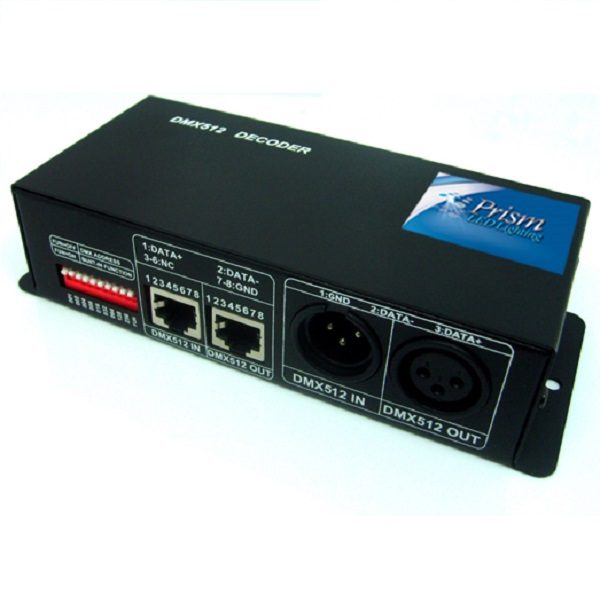 DMX 512 is an industry standard communication protocol for controlling lighting systems via computer or independent lighting controller. It allows you to program individual parameters to your lighting fixtures.
DMX 512 is an industry standard communication protocol for controlling lighting systems via computer or independent lighting controller. It allows you to program individual parameters to your lighting fixtures.
For example, on a RGB LED light, you can control the overall intensity of the light or the intensity of each individual color to achieve any color you desire.
Pictured is Prism's PTSL-CTL-I4-4CH-DMXDECO Decoder, a 4-channel DMX Decoder with RGBW interface controller that receives standard DMX-512 digital control signal and transforms it into PWM signal for driving LED strips and modules.
Q: What is RGB?
A: 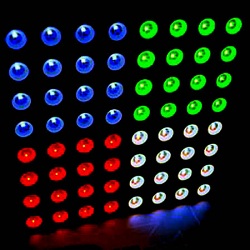 RGB stands for Red, Green, Blue. Many RGB lights on the market have a series of red, green and blue Light Emitting Diodes (LED). In theory, you should be able to mix the color temperatures of these three LEDs to obtain 16 million different color configurations.
RGB stands for Red, Green, Blue. Many RGB lights on the market have a series of red, green and blue Light Emitting Diodes (LED). In theory, you should be able to mix the color temperatures of these three LEDs to obtain 16 million different color configurations.
For example, if you mix red and blue, you can get different shades of purple or magentas. If you mix blue and green, you get a range of cyan or aqua colors. If you mix red and green together you get oranges and yellows. If you mix all three, you get white.
Q: What is the difference between Task Lighting and Accent Lighting?
A: 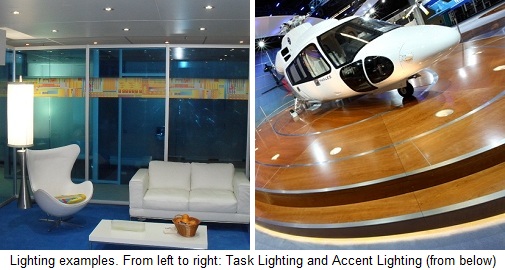 Task Lighting is lighting that is directed to a specific area to provide illumination for the performance of a visual task, e.g. general booth lighting that helps the overall lighting level in your exhibit.
Task Lighting is lighting that is directed to a specific area to provide illumination for the performance of a visual task, e.g. general booth lighting that helps the overall lighting level in your exhibit.
Accent Lighting is any lighting source from almost any direction which is used in addition to task lights to help call attention to an object or area, not the lighting, e.g. graphic lighting, kick plate illumination on counters, etc.
Learn more about LED Arm Lights for Task lighting >
Learn more about LED Up/Down Lights for Accent lighting >
Q: What are Lumens?
A: 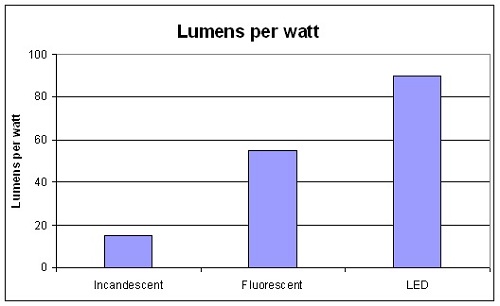 Lumens (luminous flux) is a measure that is used for the intensity of light output.
Lumens (luminous flux) is a measure that is used for the intensity of light output.
When an LED's specification says the LED is 90lm/watt, it means that it is 90 lumens for every one watt.
For example, a five watt LED lamp that is 90lm/watt it is putting out 450 lumens.
That is equal to a 50W halogen lamp.
Q: Why is there such a price difference between different LED suppliers for LED flexible ribbon lighting?
A: 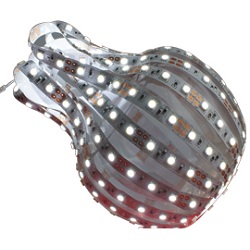 We have seen prices vary as much as 300% between different manufacturers of LED flexible ribbon lighting. This is primarily due to the quality of the components being used. Less expensive usually means inferior quality, and when you're setting up flexible LED ribbon lighting in your booth you want to know the product will not start breaking down on day one of the show. To reduce their manufacturing costs and keep prices low, manufacturers will purchase substandard LED's and other electronic components.
We have seen prices vary as much as 300% between different manufacturers of LED flexible ribbon lighting. This is primarily due to the quality of the components being used. Less expensive usually means inferior quality, and when you're setting up flexible LED ribbon lighting in your booth you want to know the product will not start breaking down on day one of the show. To reduce their manufacturing costs and keep prices low, manufacturers will purchase substandard LED's and other electronic components.
Also, beware of manufacturers who offer a '5 YEAR WARRANTY.' The design of LED flexible ribbon lighting will not allow it to last that long, so they are misleading you. In order to last five years, significantly more electronic components would be required than is typically designed in your common LED flexible ribbon light, so if a company is offering such a warranty make sure you read the fine print.
Q: Does LED lighting get hot?
A: 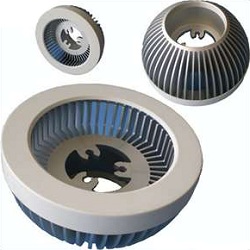 In comparison to halogen lighting, LED lights generate much less heat, up to 90% less in some cases. There are situations though where LED lights can get hot to the touch, don't be alarmed.
In comparison to halogen lighting, LED lights generate much less heat, up to 90% less in some cases. There are situations though where LED lights can get hot to the touch, don't be alarmed.
If you're using high-power LED's or have multiple LED's close together, this will generate heat. The proper way to deal with this heat is to have what's known as a metal heat sink attached to the electronics of the LED light to help extract heat away from the LED. Quality-built LED lights will have a well-engineered heat sink to help with this issue.
It is not uncommon for the metal heat sink of an LED light to get up to 70 degrees Celsius. While this is hot to the touch it is an OK temperature for the LED. Another thing to remember is that the heat is always contained within the metal part of the heat sink. There is very little heat emitted from the light ray coming from the LED, so you will feel no heat when standing directly underneath the LED light fixture.
On the other hand, a halogen light's heat energy is emitted from the lamp itself and can be felt when standing under or near the halogen light source. As a result, you see more and more exhibitors converting from halogen to LED lighting for a more comfortable booth environment for both the vendor and attendees - remember that when thinking about lighting for your next booth.
Q: What Dimmers are recommeded for use with TRAIC Power Supplies?
A: A list of our recommenced compatible dimmers switches can be found here: List of Compatible Dimmers
